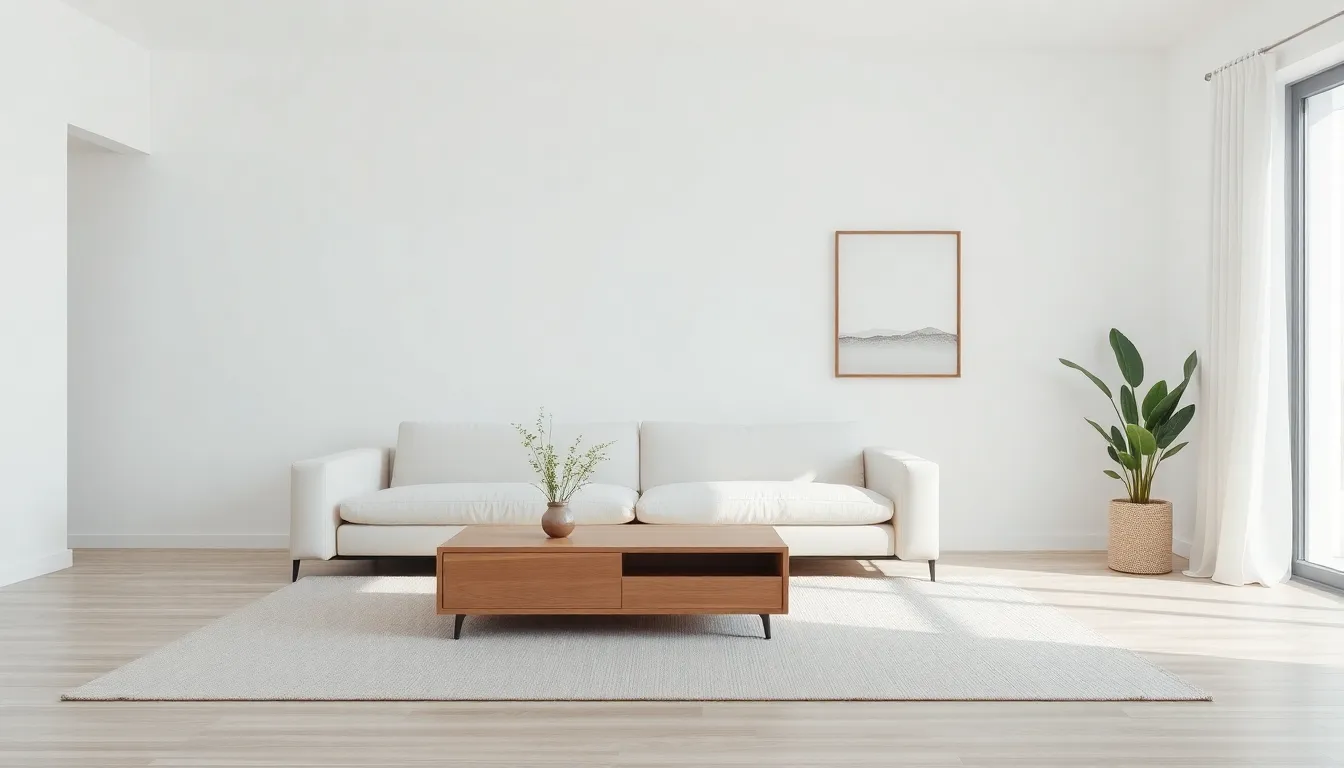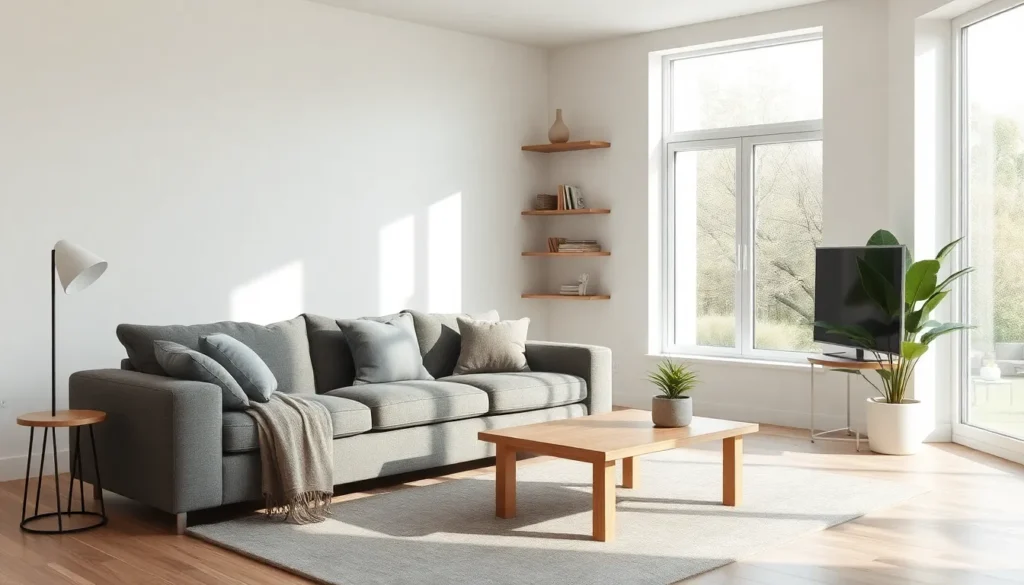In a world overflowing with clutter, the minimalist living room design emerges like a breath of fresh air, inviting tranquility and style into everyday life. Imagine stepping into a space where less truly is more—where every piece of furniture serves a purpose and every corner whispers serenity. It’s not just about tossing out the old junk; it’s about curating a sanctuary that reflects simplicity and sophistication.
Table of Contents
ToggleOverview of Minimalist Living Room Design
Minimalist living room design focuses on simplicity and functionality. The concept revolves around reducing excess while maximizing elegance. Purposeful furniture plays a significant role in this style. Each piece complements its surroundings, enhancing the overall aesthetic without overwhelming it.
A tranquil atmosphere is a priority in minimalist design. Neutral color palettes, such as whites and grays, promote calmness. Natural light enhances the sense of openness, creating a spacious feel. Incorporating plants introduces warmth and vibrancy, linking the interior to nature.
Storage solutions significantly contribute to maintaining a clutter-free environment. Built-in shelving and multifunctional furniture serve both practical and aesthetic purposes. For example, an ottoman that doubles as storage encourages organization while offering seating. Each item in the living room should have a clear purpose.
Textures add depth to minimalist spaces. Soft fabrics, smooth metals, and natural woods blend harmoniously. By focusing on quality over quantity, individual elements stand out more. Lighting fixtures can also highlight architectural features or artwork, making them focal points.
Incorporating art supports personalization without compromising simplicity. Select few pieces create impact without crowding the space. This approach ensures the living room remains cohesive and inviting.
Minimalist living room design embodies the idea of less is more. De-cluttering is just the beginning of creating a sophisticated sanctuary. Insightful design choices lead to a space that not only looks stylish but also feels serene and functional.
Key Elements of Minimalist Design

Minimalist living room design hinges on specific elements that foster simplicity and tranquility. Understanding these key components can enhance both functionality and aesthetics.
Color Palette
Neutral colors define minimalist spaces. Shades of white, beige, gray, and soft pastels create a calm backdrop. These tones reflect natural light, amplifying brightness in the room. Darker hues may serve as accents but should remain subtle to maintain balance. Color palettes often emphasize cohesion, ensuring that all elements seamlessly blend together. Effective use of color enhances the serene atmosphere without distraction.
Furniture Selection
Selecting purposeful furniture is crucial in minimalist design. Each piece should serve a specific function while contributing to the overall aesthetic. Sofas with clean lines and simple silhouettes work well in these settings. Preference often lies with natural materials such as wood and leather for durability and warmth. Multi-functional furniture, like coffee tables with storage capabilities or ottomans that double as seating, reduces clutter. Designers also prioritize minimalist designs that allow for easy movement and flow within the space.
Decor and Accessories
Limited decor defines minimalist design. Fewer accessories mean each piece receives more attention. Artwork should be strategically chosen, focusing on one or two statement pieces rather than overcrowding walls. Textures play an important role, with soft textiles like throws or cushions adding warmth without visual chaos. Plants enhance the environment and introduce organic elements, promoting calmness. Decorative items should reflect personal style but remain understated and curated for maximum impact.
Benefits of Minimalist Living Room Design
Minimalist living room design offers various benefits that enhance both aesthetics and functionality. This approach creates a harmonious and inviting atmosphere that resonates with clarity and peace.
Space Optimization
Open layouts are a hallmark of minimalist design, effectively maximizing space usage. Fewer pieces of furniture create a more functional environment, allowing for easy movement. Purposeful design often incorporates multifunctional furniture, such as storage ottomans or convertible sofas, which streamline living areas. Built-in storage solutions minimize clutter, keeping surfaces clean and organized. Light colors amplify the sense of spaciousness, reflecting natural light to brighten the room. Every choice reinforces the feeling of openness and accessibility, transforming even small spaces into inviting sanctuaries.
Stress Reduction
Simplicity is a powerful antidote to stress in minimalist living rooms. By eliminating visual distractions, minimalist design promotes a serene ambiance that encourages relaxation. Neutral color palettes calm the mind, reducing anxiety triggered by clutter. Purposeful arrangement of furniture creates defined areas for activities, such as reading or socializing, enhancing purposeful interactions. Incorporating elements of nature, like houseplants, adds a soothing effect while purifying the air. This minimal approach fosters tranquility, allowing individuals to unwind and rejuvenate in their personal space.
Tips for Achieving Minimalist Living Room Design
Creating a minimalist living room involves strategic choices. Focus on elements that promote simplicity and functionality.
Decluttering Strategies
Start by assessing furniture. Keeping only essential pieces simplifies the space. Next, employ storage solutions like baskets or hidden compartments, which maintain organization. Regularly evaluate decor items too; a limit of one or two standout pieces prevents visual clutter. Use the “one in, one out” rule for maintaining a consistent aesthetic. Identify frequently used items, ensuring they remain accessible yet neatly stored. Avoid decorative excess by prioritizing quality over quantity in furnishings and accessories. Regular decluttering sessions create ease and maintain serenity in the space.
Choosing the Right Layout
Establishing the right layout enhances functionality. Begin with an open floor plan that encourages movement and flow. Arrange furniture to facilitate conversation, positioning seating within close proximity. Use natural pathways to avoid overcrowding; a clear path significantly enhances comfort. Consider multifunctional furniture such as ottomans with storage capabilities. Focal points like a simple coffee table or a statement art piece should remain unobstructed. Prioritizing balance and proportionality ensures visual harmony. Lighting fixtures also play a crucial role; placing them strategically enhances both ambiance and functionality.
Embracing minimalist living room design transforms a space into a serene retreat. By focusing on functionality and simplicity, individuals can create an inviting atmosphere that promotes relaxation and clarity. Purposeful furniture choices and effective storage solutions enhance both aesthetics and usability, while natural elements add warmth and vibrancy.
Incorporating a few select decor pieces allows for personalization without overwhelming the space. Ultimately, minimalist design not only elevates the visual appeal but also fosters a peaceful environment that encourages mindfulness and tranquility. Adopting these principles can lead to a more organized and harmonious living area that reflects a refined lifestyle.

